<< Previous | Displaying results 4026-4050 of 6771 for "" | Next >>
Many observers at the IMT, aware of the historic nature of the trial, created scrapbooks to preserve their own record of the Nuremberg court. First Lieutenant Herman E. Klappert, Jr. was a photographer with the U.S. Army Signal Corps who assembled three such scrapbooks. Klappert's albums consist almost entirely of photographs that he printed himself. Also included in the albums are original autographs from the defendants and other principal figures at the trial, official identification cards issued to…
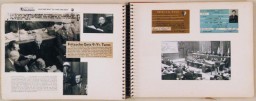
Many observers at the International Military Tribunal (IMT) at Nuremberg, aware of the historic nature of the trial, created scrapbooks to preserve their own record of the Nuremberg court. First Lieutenant Herman E. Klappert, Jr. was a photographer with the U.S. Army Signal Corps who assembled three such scrapbooks. Klappert's albums consist almost entirely of photographs that he printed himself. Also included in the albums are original autographs from the defendants and other principal figures at the…
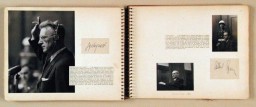
Entry pass to the prison housing war criminals at the International Military Tribunal. This pass was issued to a U.S. military guard.

Back side of an entry pass to the prison housing war criminals at the International Military Tribunal. This pass was issued to a U.S. military guard.
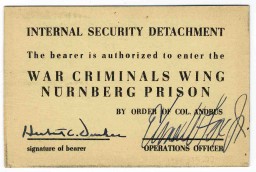
This map of the Treblinka I forced-labor camp was drawn by Holocaust survivor Manfred Kort in 1946. In 1990 Kort donated the map to the United States Holocaust Memorial Musem. In March 1997, at the request of the Office of Special Investigations, the Museum sent the original drawing to Chicago to be used as evidence at the trial of one Bronislaw Hajda. At the conclusion of Hajda's trial on April 10, 1997, the U.S. Department of Justice announced that "a federal judge in Chicago has revoked the naturalized…
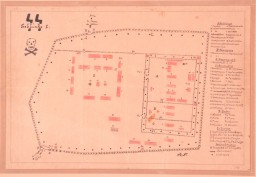
Headphones used by defendant Hans Frank during the International Military Tribunal. Headphones like these enabled trial participants to hear simultaneous translation of the proceedings.
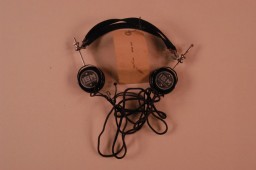
Headphones used by defendant Hermann Göring during the International Military Tribunal. Headphones like these enabled trial participants to hear simultaneous translation of the proceedings.
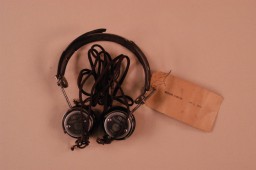
Headphones used by defendant Albert Speer during the International Military Tribunal. Headphones like these enabled trial participants to hear simultaneous translation of the proceedings.
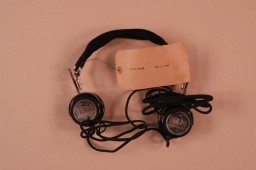
Entry pass to a US military dining hall at Dachau, Germany. This card was issued to Anton Litwin, a member of the War Crimes Branch.
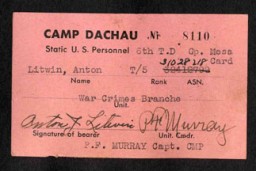
Affidavit signed by Rudolf Hoess attesting to the gassing of Jews while he was the commandant of the Auschwitz killing center. The German text reads: "I declare herewith under oath that in the years 1941 to 1943 during my tenure in office as commandant of Auschwitz Concentration Camp 2 million Jews were put to death by gassing and a 1/2 million by other means. Rudolf Hoess. May 14, 1946." The confession is also signed by Josef Maier of the US Chief of Counsel's office. A photoreproduction of the original…
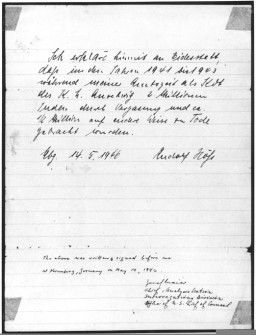
This map accompanied a secret undated German report on the mass murder of Jews by Einsatzgruppen A (mobile killing unit A). During the International Military Tribunal at Nuremberg, the map was introduced as evidence by both the American and British prosecution teams. The document, entitled "Jewish Executions Carried Out by Einsatzgruppen A" and stamped "Secret Reich Matter," shows the number of Jews executed (symbolized by coffins) in the Baltic states and Belorussia by late 1941. The legend near the…

An August 6, 1972, Washington Post article about former concentration camp guard Hermine Braunsteiner Ryan, entitled "From a Dark Past, A Ghost the U.S. Won't Allow to Rest".
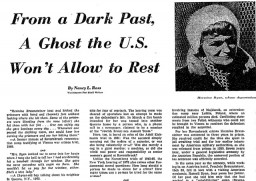
Courtroom sketch by artist David Rose of Nobel laureate and Holocaust survivor Elie Wiesel on the witness stand at the trial of Klaus Barbie. During his testimony, Wiesel stated that "The killer kills twice. First, by killing, and then by trying to wipe out the traces." June 2, 1987.
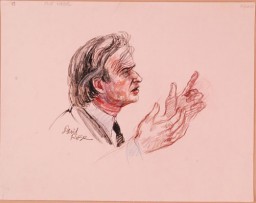
Evidence tag from the trial of Klaus Barbie in Lyon, France. This standard police form lists Barbie's infractions as crimes against humanity and complicity, concepts defined at the International Military Tribunal at Nuremberg decades earlier. The line in which the victims' names would be recorded is left blank. February 25, 1983.

Evidence tag from the trial of Klaus Barbie in Lyon, France. This standard police form lists Barbie's infractions as crimes against humanity and complicity, concepts defined at the International Military Tribunal at Nuremberg decades earlier. The line in which the victims' names would be recorded is left blank. February 25, 1983.
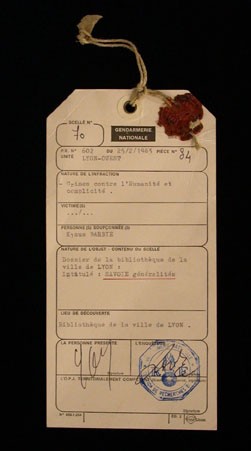
A March 3, 1967, New York Times article about Simon Wiesenthal entitled, "Relentless Nazi-Hunter."
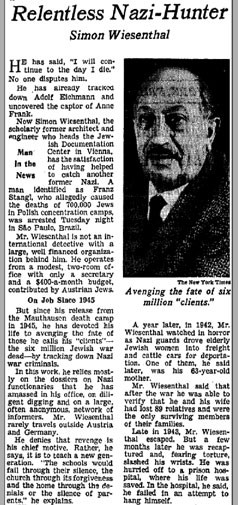
Single-use entry pass for the trial of Adolf Eichmann in Jerusalem, Israel. June 8, 1961.
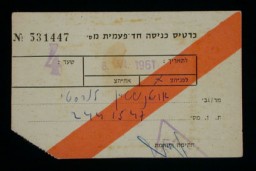
International Military Tribunal entry pass for Benjamin Ferencz, war crimes investigator and later chief prosecutor in the Einsatzgruppen Trial.
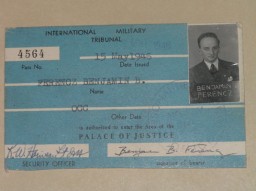
Pass issued to Benjamin Ferencz, war crimes investigator and later chief prosecutor in the Einsatzgruppen Trial. This pass granted the bearer free movement within the US-occupied zone of postwar Germany.
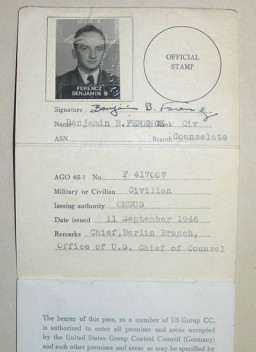
Eugenics poster entitled "The relationship between Jews and Freemasons." The text at the top reads: "World politics World revolution." The text at the bottom reads, "Freemasonry is an international organization beholden to Jewry with the political goal of establishing Jewish domination through world-wide revolution." The map, decorated with Masonic symbols (temple, square, and apron), shows where revolutions took place in Europe from the French Revolution in 1789 through the German Revolution in 1919. This…

Illustration from cover of a German anti-Masonic pamphlet by Friedrich Haffelbacher, entitled "Das Todesurteil ueber die Freimaurerei in Deutschland" [The Death Sentence for Freemasons in Germany].
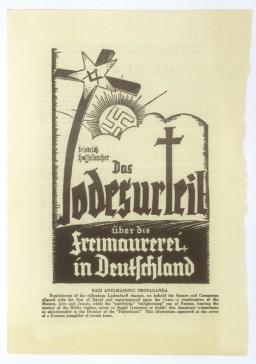
A special issue of Serbian stamps bearing antisemitic and anti-Masonic themes dating from the German occupation. The series was issued for an exhibition on Jews and Freemasons in Belgrade in 1942.
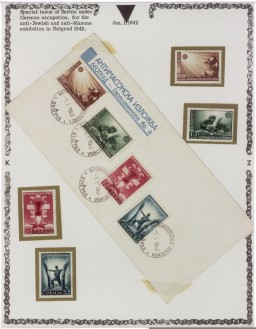
Brochure published by the Unitarian Service Committee describing its relief mission in Nazi-occupied Europe.
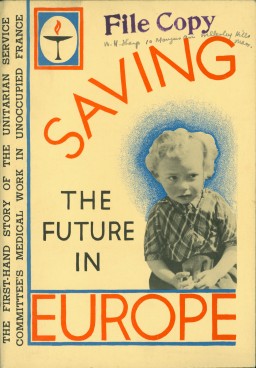
This Singer sewing machine was used by shoemakers in the Lodz ghetto, Poland. As early as May 1940, the Germans began to establish factories in the ghetto and to utilize Jewish residents for forced labor. By August 1942, there were almost 100 factories within the ghetto. The major factories produced textiles, especially uniforms, for the German army.
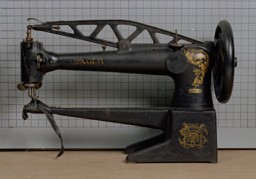
Julien Bryan stored his still photo negatives from Nazi Germany 1937 and Poland 1939 in these carefully marked metal canisters.
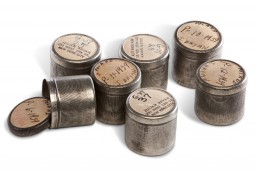
We would like to thank Crown Family Philanthropies, Abe and Ida Cooper Foundation, the Claims Conference, EVZ, and BMF for supporting the ongoing work to create content and resources for the Holocaust Encyclopedia. View the list of donor acknowledgement.